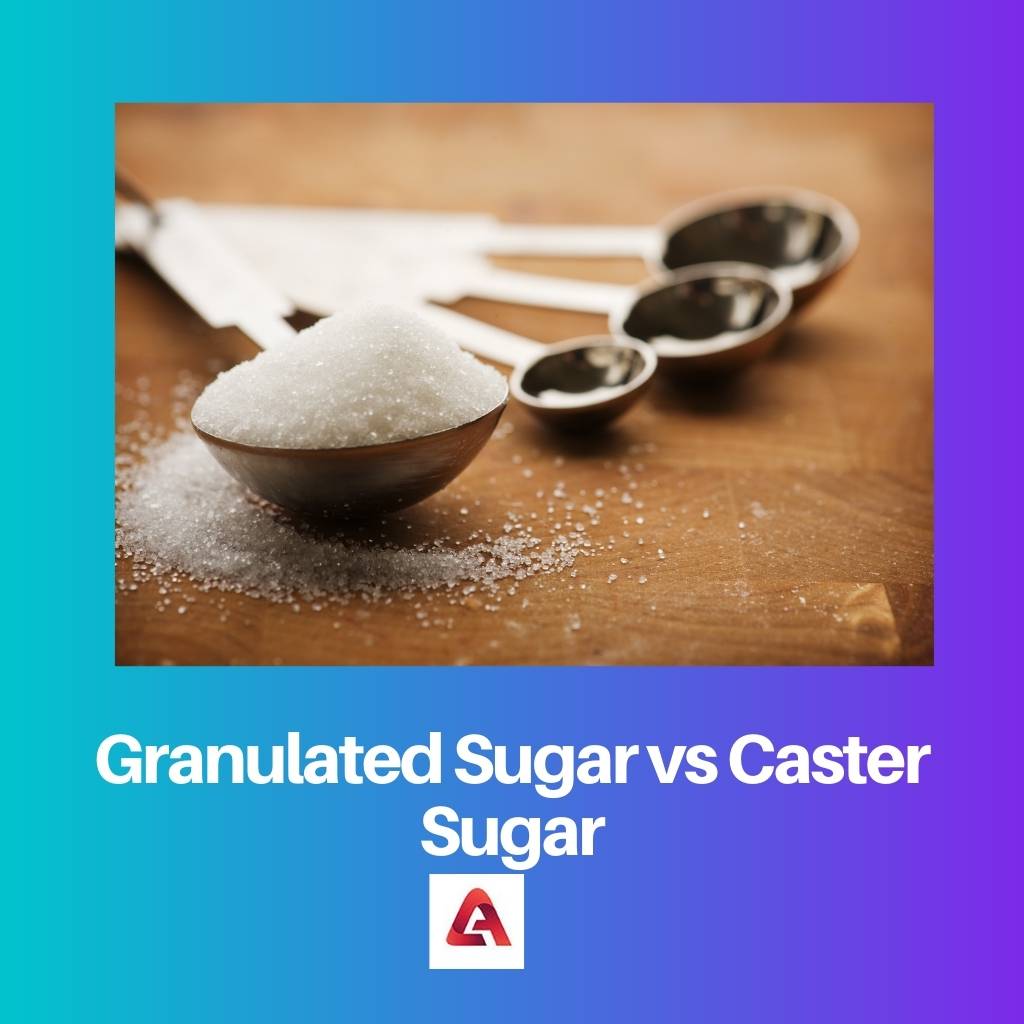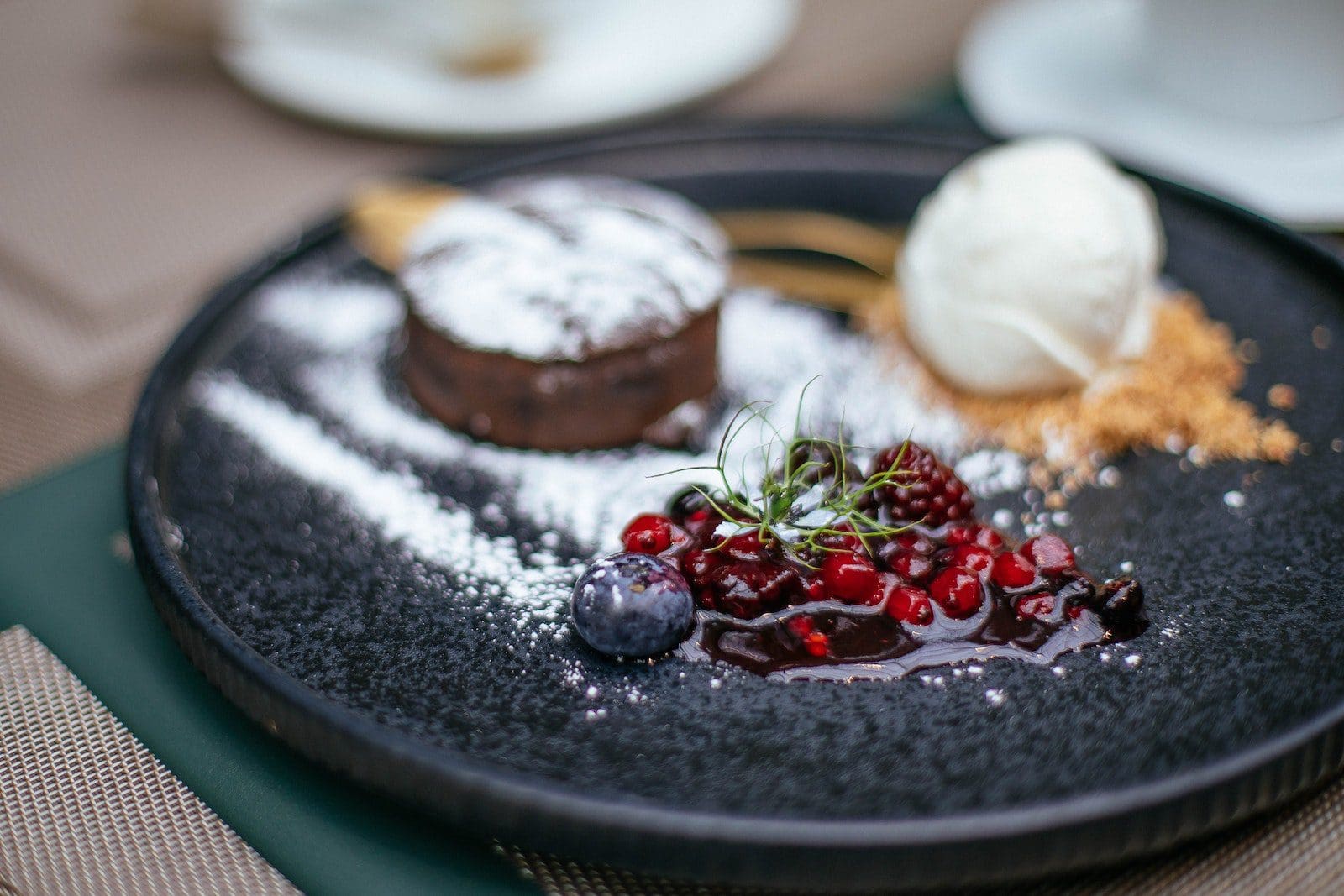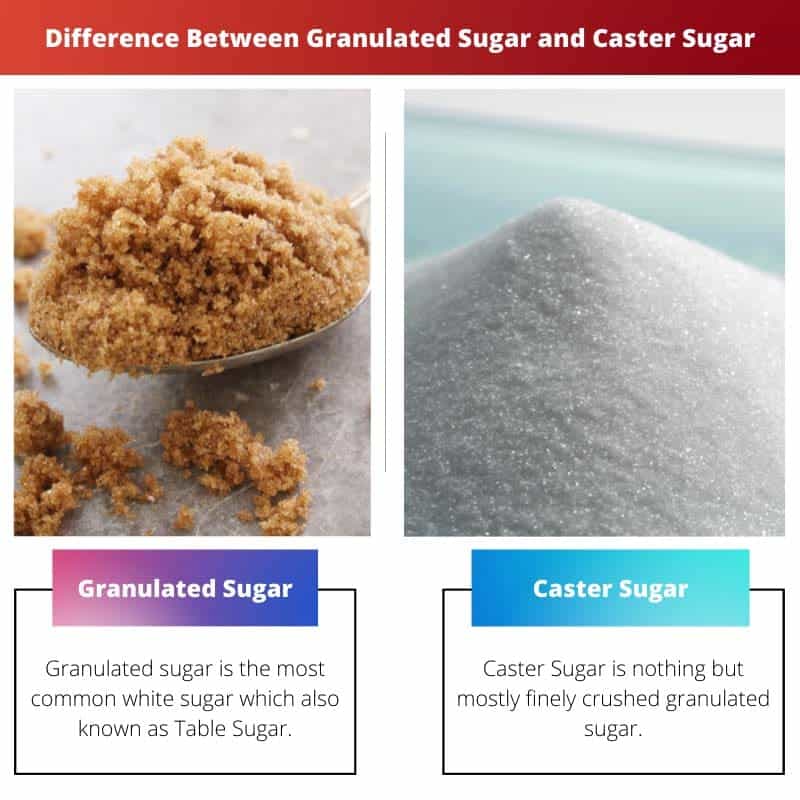Many types of sugar worldwide exist, such as Glucose, Fructose, Sucrose, and Lactose.
- Glucose is a type of sugar that is commonly found in fruits.
- Fructose is also a sugar found in plants and bonded with glucose.
- Sucrose is an ordinary sugar which is also called Table Sugar.
- Lactose is a type of dairy sugar.
All of the above sugars have different molecular formulas and properties. Granulated Sugar and Castor Sugar both are types of Sucrose Sugar.
Key Takeaways
- Granulated sugar and caster sugar are two types of refined sugar that differ in crystal size and texture.
- Granulated sugar has larger, coarser crystals and is commonly used in baking, cooking, and sweetening drinks.
- Caster sugar, or superfine sugar, has smaller, finer crystals and is used in delicate baked goods, meringues, and cocktails.
Granulated Sugar vs Caster Sugar
The difference between Granulated Sugar and Caster Sugar is their size. And because of this reason, they have different characteristics and properties. Caster Sugar is used more commonly as it has more usage than Granulated Sugar. And Caster Sugar became very famous, and the main reason for making it is its small size.

Granulated Sugar is the Sucrose type of Sugar extracted from sugarcane and from the mixture of Fructose and Glucose, which are other types of Sugar. Due to its larger size, its usage of it is significantly less. And also Granulated Sugar was first developed in India.
Caster Sugar is also a Sucrose type of Sugar as it is only finely crushed Granulated Sugar introduced in the 90s.
When Caster Sugar is developed, various properties of The Granulated Sugar change, and because of its smaller size, it is preferred mainly across the world.
Comparison Table
| Parameters of Comparison | Granulated Sugar | Caster Sugar |
|---|---|---|
| Made | From Sucrose | Crushing granulated/white sugar |
| Size | 0.5mm in diameter | 0.35mm in diameter |
| Solubility | Comparatively Less Solubility | High Solubility |
| Presence of Moisture | Takes less moisture due to enormous size. | Takes more moisture due to small size. |
| Usage | Baking, making Toffee, Normal Cooking. | Baking cake, meringues, and Pavlova. |
What is Granulated Sugar?
Granulated sugar is the most common white sugar or Table Sugar. It is said that Granulated Sugar was first introduced in India and then spread across the world during the 80s before that liquid sugar was used.
It is a sucrose sugar made from sugarcane and composed of fructose and glucose. This is the type of sugar it takes to dissolve in the water.
Sugarcanes are collected, and the juice is extracted; then, the liquid is turned into giant sugar crystals by extracting, filtering, purifying, and crystallizing.
Also, it is not preferred for making the cake due to its large size. But along with this disadvantage because of its large size, there is an advantage too, i.e. it can be transported easily as there is no chance of clumping at higher temperatures and a good option for buying a larger quantity.
This type of sugar is best for baking, dissolving in liquids, and sprinkling on top of cookies or biscuits.

What is Caster Sugar?
In simple words, Caster Sugar is nothing but primarily finely crushed granulated sugar; therefore, it is a sucrose type of sugar that is, made from crystals of sugarcane juices. It is considered the best for baking cakes because of its tiny and delicate crystals, which mix up very quickly.
Therefore it is used in the making of cocktails. Caster sugar was introduced in the 90s, and today can be found in Australia the most.
It has more advantages as compared to Granulated Sugar. For example, it gets dissolved easily; therefore, it can be used for more baking at most places where Granulated Sugar is used.
Also, Caster Sugar and Granulated Sugar don’t weigh the same, which is why caster sugar is much more affordable than Granulated Sugar. It is not suitable for bulk use.
Also, an extraordinary temperature is required to transport the Caster Sugar as there will be clumping at a higher temperature. It takes in more moisture because of its small size. And the price of casters sugar is much cheaper than the price of granulated sugar.

Main Differences Between Granulated Sugar and Caster Sugar
- Sucrose is used to make Granulated Sugar, made out of Sugar and a mixture of fructose and glucose, whereas Caster Sugar is made out of Granulated Sugar by finely crushing it.
- Caster sugar is made by finely grinding the Granulated Sugar, but both have different sizes. Granulated Sugar is 0.5mm in diameter, and the size of Caster Sugar is 0.35mm in diameter.
- Due to its smaller size, the solubility of castor sugar is higher than Granulated Sugar; therefore, it is dissolved in water or liquid more easily.
- The particles of Granulated sugar take in less sugar than the Caster Sugar, and the reason behind it is the size of the Granulated Sugar.
- Granulated Sugar is used in baking (pastries) and Making Toffee; in everyday cooking, it is not used in making the cake. On the other hand, Caster Sugar is used in Baking (cakes and everything) and making Meringues and Pavlova.


I appreciate the focus on the historical context of sugar production and how it has influenced modern usage. It makes the topic more engaging.
The historical insights are indeed engaging. It shows that the evolution of these sugars is tied to wider cultural and economic changes.
Agreed, the historical background provides a broader perspective on the significance of different sugar types in culinary practices.
I’m glad to learn about Granulated Sugar and Caster Sugar in such detail. As a cooking enthusiast, this has been quite enlightening.
Definitely! The comparison table makes it easier to understand their differences and applications.
This is a very comprehensive explanation of different types of sugar and their properties. I’m really impressed with the research behind this article.
I agree! This article provides a wealth of information about sugar varieties.
The details about the differences in particle size and solubility between Granulated Sugar and Caster Sugar are precisely explained. It’s quite educational.
I couldn’t agree more. The scientific information provided in this article is commendable.
The detailed description of sugar types and their applications offers valuable information for enthusiasts and professionals alike.
Absolutely, the educational value of this content is apparent. It serves as an excellent resource for culinary learning.
I found the section about the origins of Granulated Sugar and the development of Caster Sugar very interesting. It adds historical context to the topic of sugar production.
Absolutely! Knowing the history behind these sugars enhances our understanding of how they are used today.
I agree, the article offers a lot of valuable insights into the evolution of sugar as an essential ingredient.
The article’s detailed explanation about the origins and development of Caster Sugar is enlightening. Great read for those interested in the culinary sciences.
Absolutely, the information provided could be quite beneficial for professionals in culinary arts and food science.
The intricate details and nuanced comparisons of Granulated Sugar and Caster Sugar make this article an enlightening resource for culinary enthusiasts.
Absolutely, this article is an engaging blend of history, science, and culinary insights.
I couldn’t agree more. The level of depth and precision in the content is commendable.
The comparative analysis of Granulated Sugar and Caster Sugar is thorough and well-presented. It’s beneficial for anyone looking to understand these distinctions.
Absolutely, the clarity in the comparisons makes it easy for readers to comprehend the properties and uses of these sugars.
The scientific details about the molecular composition and properties of different sugars are fascinating. This article offers much more than basic comparisons.
Absolutely, the analytical approach to this topic is well-suited for readers with a keen interest in food chemistry.
I agree. The depth of scientific information elevates the discussion about sugar types to a more advanced level.